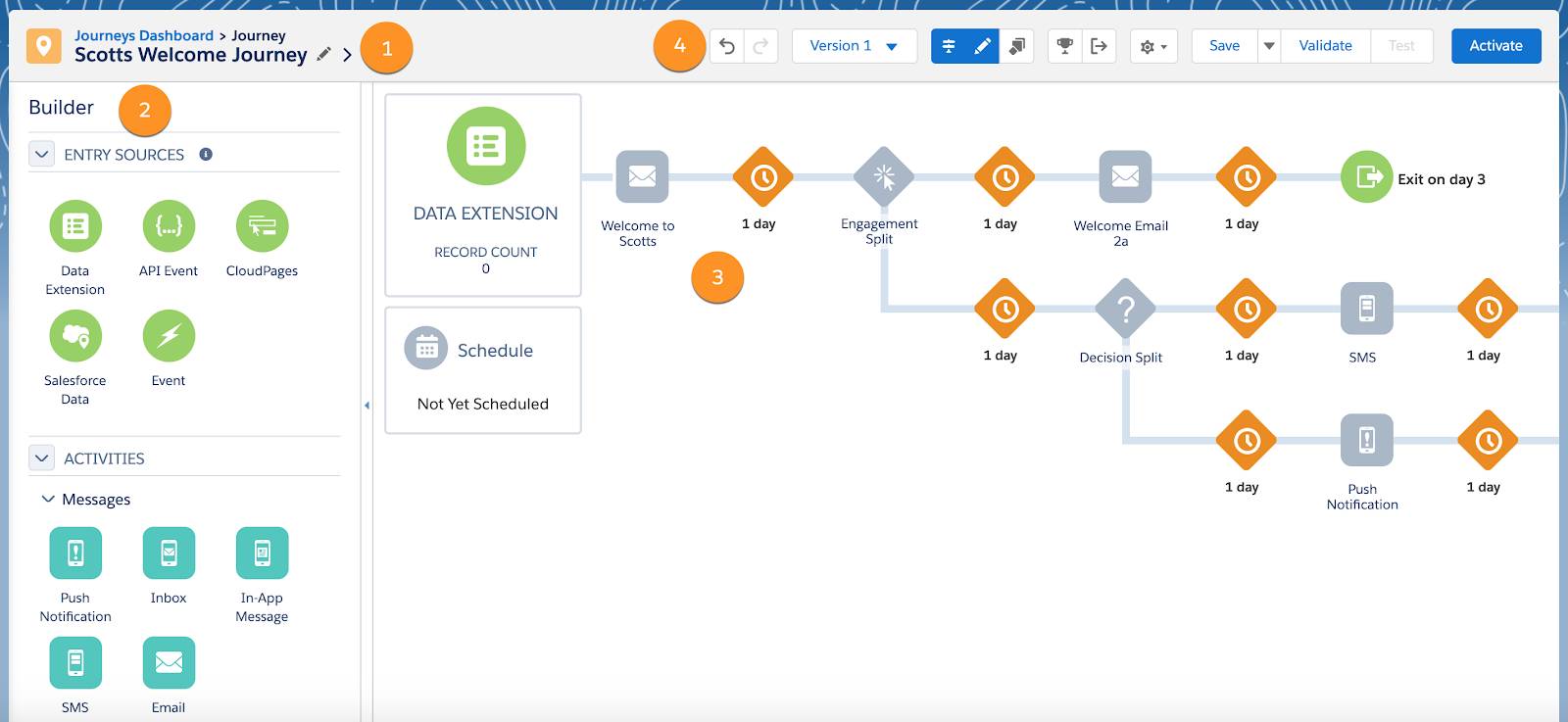
Salesforce Journey Builder: Complete Buyer's Guide
Enterprise-grade customer journey orchestration platform
Salesforce Journey Builder is an enterprise-grade customer journey orchestration platform that integrates Einstein AI capabilities with cross-channel marketing automation as part of Salesforce Marketing Cloud. The platform enables real-time journey orchestration across email, SMS, advertising, and messaging channels, powered by machine learning-driven personalization features including Send Time Optimization, Frequency Split, and Scoring Split for behavioral targeting[223][226][228].
Market Position & Maturity
Market Standing
Salesforce Journey Builder occupies a premium position in the enterprise customer journey orchestration market, leveraging Salesforce's dominant CRM market presence to deliver integrated marketing automation capabilities. The platform benefits from Salesforce's 73% market penetration in hospitality and strong B2B market presence[118][121].
Company Maturity
Company maturity indicators demonstrate Salesforce's operational stability and long-term viability as a vendor. The platform represents part of Salesforce's comprehensive Marketing Cloud offering, backed by the company's substantial R&D investment in Einstein AI capabilities and continued platform development.
Growth Trajectory
Growth trajectory analysis suggests Journey Builder benefits from the broader 25% annual growth in AI-driven CX solutions, though specific platform adoption metrics require independent verification[111].
Industry Recognition
Industry recognition reflects Journey Builder's established market presence, though specific analyst rankings require verification against current market assessments.
Strategic Partnerships
Strategic partnerships within the Salesforce ecosystem provide Journey Builder with distribution advantages and technical integration capabilities that enhance its competitive position.
Longevity Assessment
This enterprise-grade foundation provides buyer confidence in vendor longevity and continued product evolution.
Proof of Capabilities
Customer Evidence
Journey Builder demonstrates proven effectiveness through documented customer implementations across multiple industries and use cases. Booking confirmation journeys consistently show enhanced customer satisfaction through automated, personalized communication sequences that improve overall customer experience metrics[225]. Loyalty program implementations demonstrate improved engagement rates when journey triggers align with customer behavior patterns, enabling more effective retention strategies[227].
Quantified Outcomes
Quantified deployment outcomes show organizations with centralized data repositories achieve 3.5x faster implementation compared to those requiring extensive data unification work[4][38]. Cross-functional alignment reduces implementation risk by 40%[60].
Market Validation
Market adoption indicators suggest positive customer retention and expansion within existing Salesforce customer base, though specific metrics require independent verification.
Competitive Wins
Competitive validation emerges through Journey Builder's cross-channel testing capabilities that differentiate from competitors focused primarily on single-channel optimization[121].
Reference Customers
B2B application success represents Journey Builder's strongest validation area, with customer implementations reporting reduced manual coordination requirements between marketing and sales teams through automated lead scoring and handoff processes[230].
AI Technology
Journey Builder's technical foundation centers on Einstein AI integration that delivers three primary machine learning capabilities validated through customer implementations. Send Time Optimization uses predictive algorithms to determine optimal message timing for individual customers, while Frequency Split prevents over-communication by analyzing engagement patterns to maintain optimal contact frequency[223][226]. The platform's Scoring Split functionality enables dynamic journey branching based on predictive customer scoring models that adapt in real-time to behavioral changes.
Architecture
The platform's real-time orchestration architecture processes customer behavior data to automatically advance users through predetermined journey stages, with decision points based on engagement history, demographic attributes, and predictive scoring.
Primary Competitors
Journey Builder competes primarily against Adobe Journey Optimizer and Oracle's enterprise solutions.
Competitive Advantages
Journey Builder's primary competitive advantages center on deep Salesforce ecosystem integration that enables unified customer views across sales, service, and marketing touchpoints. Cross-channel testing capabilities differentiate Journey Builder from competitors focused primarily on single-channel optimization[121].
Market Positioning
Competitive market positioning places Journey Builder against enterprise alternatives like Adobe Journey Optimizer and Oracle, with each platform emphasizing different strengths.
Win/Loss Scenarios
Win/loss scenarios favor Journey Builder when existing Salesforce ecosystem investments justify platform integration benefits and when cross-channel orchestration requirements exceed single-channel solutions' capabilities.
Key Features

Pros & Cons
Use Cases
Pricing
Featured In Articles
Comprehensive analysis of AI Customer Journey Mapping for AI Marketing & Advertising for AI Marketing & Advertising professionals. Expert evaluation of features, pricing, and implementation.
How We Researched This Guide
About This Guide: This comprehensive analysis is based on extensive competitive intelligence and real-world implementation data from leading AI vendors. StayModern updates this guide quarterly to reflect market developments and vendor performance changes.
234+ verified sources per analysis including official documentation, customer reviews, analyst reports, and industry publications.
- • Vendor documentation & whitepapers
- • Customer testimonials & case studies
- • Third-party analyst assessments
- • Industry benchmarking reports
Standardized assessment framework across 8 key dimensions for objective comparison.
- • Technology capabilities & architecture
- • Market position & customer evidence
- • Implementation experience & support
- • Pricing value & competitive position
Research is refreshed every 90 days to capture market changes and new vendor capabilities.
- • New product releases & features
- • Market positioning changes
- • Customer feedback integration
- • Competitive landscape shifts
Every claim is source-linked with direct citations to original materials for verification.
- • Clickable citation links
- • Original source attribution
- • Date stamps for currency
- • Quality score validation
Analysis follows systematic research protocols with consistent evaluation frameworks.
- • Standardized assessment criteria
- • Multi-source verification process
- • Consistent evaluation methodology
- • Quality assurance protocols
Buyer-focused analysis with transparent methodology and factual accuracy commitment.
- • Objective comparative analysis
- • Transparent research methodology
- • Factual accuracy commitment
- • Continuous quality improvement
Quality Commitment: If you find any inaccuracies in our analysis on this page, please contact us at research@staymodern.ai. We're committed to maintaining the highest standards of research integrity and will investigate and correct any issues promptly.